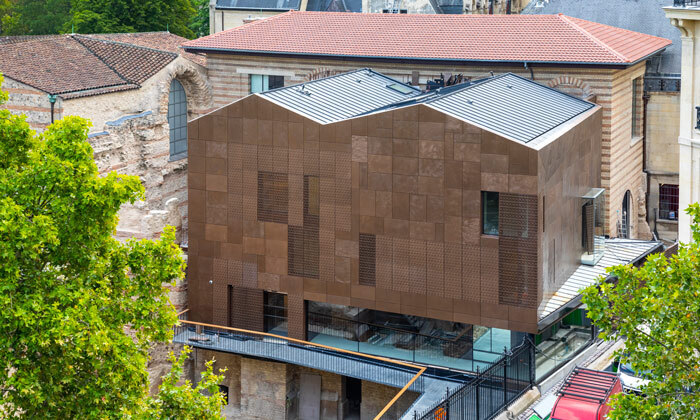In 2015, an immense upgrade project began in order to bring the museum into the 21st century. Since May 12, 2022, visitors have been able to enjoy a brand new building designed by the architect Bernard Desmoulin and can visit a brand new museum.






















Visible from boulevard Saint-Michel and accessible from rue Du Sommerard, the new reception area lends the museum greater visibility and extension and includes all the facilities expected of a modern museum.
The museum, a combination of ancient, medieval and 19th century buildings, often felt like something between a maze and an obstacle course. The many staircases and changes in level made it impossible for people with reduced mobility to access it. Bernard Desmoulin’s new building now connects these different levels and buildings thanks to the installation of ramps and elevators.

The extension has also improved the reception areas, with a new ticketing area and a more spacious bookstore/gift shop. It also includes spaces that allow the museum to better fulfill its different purposes, such as artwork management facilities, educational areas and rooms for temporary exhibitions.
Following a minimal-impact approach, the new building has simple volumes, its gables following the same pattern as the ancient elevations. The façades are clad in cast-iron panels of uneven sizes and textures, which catch the light and change color depending on the time of day.

The large swathes of metal guipure pick up on a motif featured in the stone filigree on the Flamboyant Gothic chapel of the medieval town house, resonating directly with the history of the site. These motifs diffuse a graphic yet gentle light into the building, its heavy use of wood and concrete echoing the materials in the ancient thermal baths and the medieval town house.
The museum's museography has also been completely revamped to bring it into the 21st century. Designed by the Adrien Gardère studio and the architect Bernard Desmoulin, this project places the works of art at the heart of the visitor's experience, while giving priority to natural light that honors the historical character of the site.
By removing some of the modern partitions and opening the windows to the outside, the museography regained its luminosity.
From Gallo-Roman antiquity to the dawn of the Renaissance, the Musée de Cluny offers a journey through 1500 years of history. The new tour highlights the evolution of this long period, allowing visitors to move forward in time as they move from one room to another.
The choice of a chronological tour is reinforced by the presence of a frieze at the beginning of the tour.
Thanks to the modernization project, visitors can now take advantage of redesigned areas. The bookshop has been revamped and a café offers light meals. In fine weather, the terrace extends into the courtyard of the medieval hotel, for a moment out of time.
The realization of this café was made possible thanks to the support of la Société des Amis du musée de Cluny.
Si vous souhaitez visiter le musée ou réserver une activité en individuel après le 19 janvier, aucune réservation n’est actuellement possible. Nous vous invitons à renouveler votre demande de réservation à partir du 20 janvier. Nous nous excusons pour la gêne occasionnée.
If you wish to visit the museum or book an individual activity after January 19th, please note that bookings are currently unavailable. We invite you to try again starting from January 20th. We apologize for any inconvenience caused.
Las reservas individuales para visitas o actividades después del 19 de enero no están disponibles por el momento. Por favor, vuelva a intentarlo a partir del 20 de enero. Disculpe las molestias.